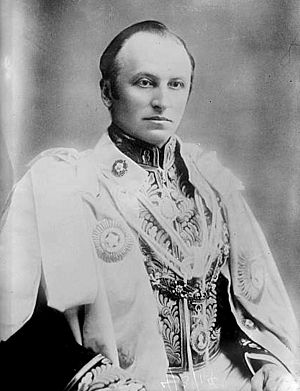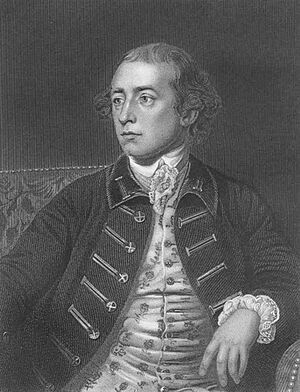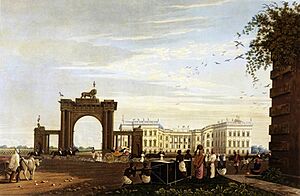Governor-General of India facts for kids
Quick facts for kids Viceroy and Governor-General of India |
|
|---|---|

Standard during the Dominion of India
|
|

Standard during the British Raj
|
|
| Style | His Excellency |
| Residence |
|
| Appointer |
|
| Term length | At His Majesty's pleasure (de jure) Five years (de facto) |
| Formation | 20 October 1773 (Fort William) 22 April 1834 (India) |
| First holder | Warren Hastings (Fort William) Lord William Bentinck (India) |
| Final holder |
|
| Abolished | 26 January 1950 |
The Governor-General of India was a very important official who represented the British monarch in India. This role existed from 1773 until 1950. From 1858 to 1947, the person holding this job was also called the Viceroy of India. The Viceroy was like a stand-in king or queen for India.
The job started in 1773 as the Governor-General of Fort William in Bengal. At first, this person only controlled their own area. But they also supervised other officials from the East India Company across India. By 1833, the Governor-General had full power over all British territories in India.
In 1858, after the Indian Rebellion of 1857, the British government took direct control of India. This period is known as the British Raj. The Governor-General then also became the Viceroy. This new title showed that they were the monarch's direct representative. They governed large areas like Bengal, Bombay, and Madras.
However, many parts of India were still ruled by local princes. These "princely states" had a special relationship directly with the British monarch. The Viceroy acted as the monarch's link to these states.
The title of Viceroy ended when India became independent in 1947. India was divided into two new countries: India and Pakistan. Both countries still had a Governor-General for a few years. But this role ended when they became republics in 1950 (India) and 1956 (Pakistan).
Before 1858, the East India Company chose the Governor-General. After that, the British monarch appointed them, following advice from the British government. After 1947, the monarch still appointed the Governor-General, but now on the advice of the new Indian government.
Governors-General usually served for five years. The first Governor-General of Bengal was Warren Hastings. The first Governor-General of all India was Lord William Bentinck. The last Governor-General of independent India was Chakravarti Rajagopalachari.
Contents
History of the Role
For a long time, the British East India Company controlled many parts of India. In 1773, the British government decided to take more control. They passed the Regulating Act 1773. This law created the job of Governor-General for the Fort William area in Bengal.
The Charter Act 1833 made the Governor-General of Fort William the Governor-General of all India. This person was still chosen by the East India Company, but the British monarch had to approve the choice.
After the Indian Rebellion of 1857, the British government took full control from the East India Company. The Government of India Act 1858 gave the monarch the power to appoint the Governor-General. This Governor-General could then appoint other leaders in India, like lieutenant governors.
India and Pakistan became independent in 1947. Governors-General continued to serve in each country. Louis Mountbatten, 1st Earl Mountbatten of Burma was the Governor-General of India for ten months after independence. After him, Indian leaders held the role. India became a republic in 1950, and Pakistan in 1956.
What the Governor-General Did

At first, the Governor-General only had power over the Bengal area. But the Regulating Act of 1773 gave them more power over foreign affairs and defense. Other British areas in India had to get approval from the Governor-General before going to war or making peace with Indian princes.
The India Act 1784 further increased these powers. It meant other governors could not make treaties or declare war without the Governor-General's permission.
The Governor-General became the main person in charge of foreign policy in India. But they only became the clear head of all British India with the Charter Act 1833. This act gave them control over all civil and military government in British India. It also gave them the power to make laws.
After 1858, the Governor-General, now called the Viceroy, was the chief administrator of India. They also represented the British monarch. India was divided into many provinces, each with its own governor. The Viceroy oversaw the most powerful princely rulers.
The Chamber of Princes was created in 1920. It was a meeting place where princely rulers could share their ideas with the government. The Viceroy usually led these meetings once a year.
When India became independent in 1947, the title of Viceroy was removed. The representative of India's monarch, King George VI, was again called the Governor-General. In 1948, C. Rajagopalachari became the only Indian Governor-General. This role was mostly ceremonial, meaning the real power was with the Indian government. After India became a republic in 1950, the president of India took over these duties.
The Governor-General's Council

The Governor-General always had a group of advisors called the Council. This Council helped them make laws and manage the government. When the Governor-General worked with the Council, they were called the "Governor-General in Council."
The Regulating Act 1773 said that four advisors would be chosen for the Council. The Governor-General had a vote and a special "casting vote" if there was a tie. But the Council's decisions were binding on the Governor-General.
In 1784, the Council was reduced to three members. The Governor-General still had a vote and a casting vote. In 1786, the Governor-General's power grew even more, as Council decisions no longer had to be followed.
The Charter Act 1833 changed the Council again. It was the first law to separate the Governor-General's executive (managing) and legislative (law-making) duties. There were four Council members. Three could take part in all discussions, but the fourth only joined when laws were being debated.
After 1858, the British monarch and the Secretary of State for India appointed the Council members.
The Indian Councils Act 1861 changed the Council's makeup. The Viceroy could also appoint more members, from six to twelve. These members debated and voted on laws.
In 1919, an Indian legislature was created. It took over some law-making duties from the Viceroy's Council. However, the Viceroy still had a lot of power over laws. They could spend money without the Legislature's approval for certain purposes. They could also stop or veto any bill.
Titles and Style
Until 1833, the title was "Governor-General of the Presidency of Fort William in Bengal." The Government of India Act 1833 changed it to "Governor-General of India."
The title "Viceroy and Governor-General" started being used in 1858. "Viceroy" means "in place of the king." This title was used when the Governor-General was acting as the monarch's representative. It showed new responsibilities, especially ceremonial ones, but it didn't give them new legal power.
The Governor-General was called His Excellency. They were the most important government official in India. The wives of Viceroys were called Vicereines and were known as Her Excellency. These special titles were not used if the British monarch was actually in India. Only King George V and Queen Mary visited India during British rule, in 1911.
Most Governors-General and Viceroys were noblemen. They often received higher noble titles during their time in India.
Flag and Symbols
From about 1885, the Viceroy of India could fly a Union Jack with a special symbol in the middle. This symbol was the 'Star of India' with a crown above it. This flag was used by many British officials in India, not just the Viceroy.
From 1947 to 1950, the Governor-General of India used a dark blue flag. It had the royal crest (a lion standing on a crown) and the word 'India' in gold letters below it. This flag was only for the Governor-General.
Residences
The early Governors-General lived in Belvedere House in Calcutta. Later, a grand building called Government House was built in Calcutta between 1799 and 1803. It was used until the capital moved to Delhi in 1912. Today, this building is called Raj Bhavan and is the home of the Governor of West Bengal.
After the capital moved, the Viceroy lived in the new Viceroy's House in Delhi. This huge palace was designed by Sir Edwin Lutyens. It took many years to build and was finished in 1929. Today, it is known as Rashtrapati Bhavan and is the home of the president of India.
Every summer, the Governors-General would move to the Viceregal Lodge in Shimla to escape the heat. The entire government would move with them. Today, the Viceregal Lodge houses the Indian Institute of Advanced Study.
See also
 In Spanish: Gobernador general de la India para niños
In Spanish: Gobernador general de la India para niños








